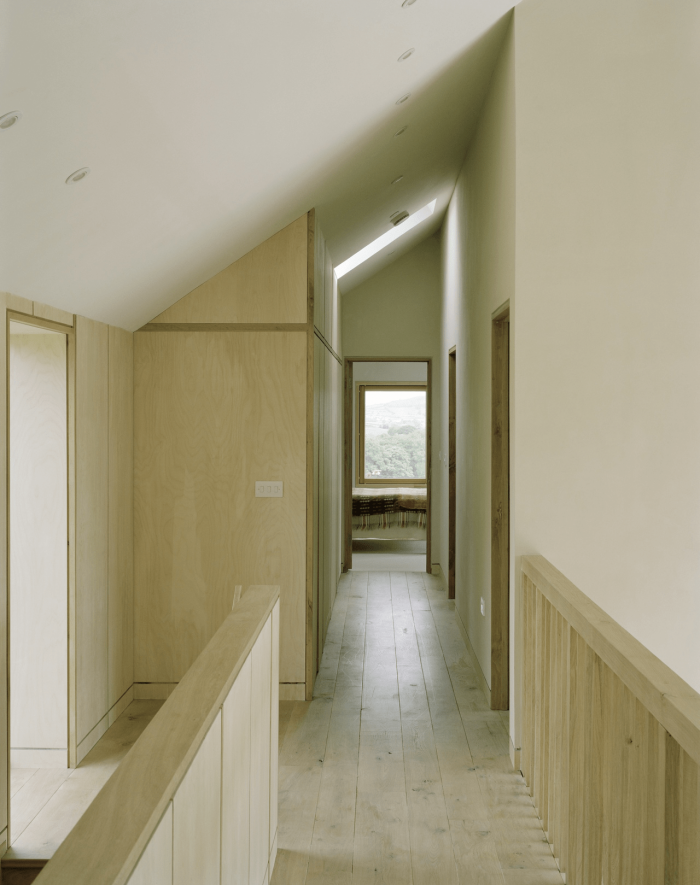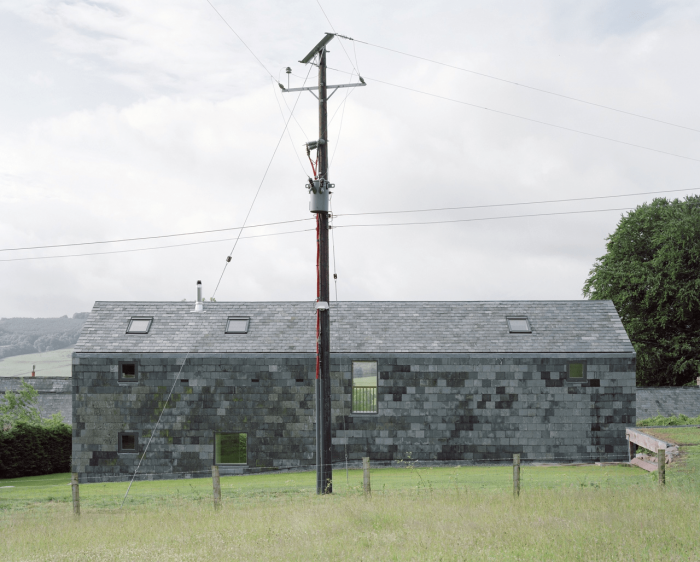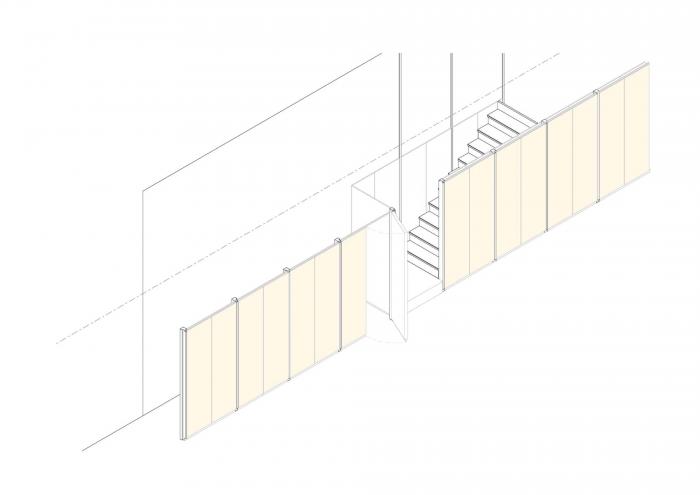简介
坐落在布雷肯比肯山脉的中间,这个位于Trallong村的线性绿地有一个向南的方向,可以看到Pen Y Fan的美景。丰富的当地风土人情激发了现代 “长屋 “的概念,它顺着土地的轮廓,嵌入到山坡上,并顺应当时的条件。我们花了两年时间,通过实地考察、模型和原型来研究和开发这个设计。该设计演变成一个清晰的挤压,使用熟练的工匠来提供一个高科技建筑。这段时间被用来采购当地材料,研究和发展我们的威尔士乡土改造。长屋的类型有利于被动式太阳能计划,并通过场地的地形和方面得到加强。当代建筑技术提供了一个彻底的现代和高性能的建筑,它与景观相呼应。该设计自始至终都是由环境驱动的。被动式太阳能设计策略使用了所有可用的自然能源,并辅以主动功能,如原木锅炉。
Introduction
Situated in the midst of the Brecon Beacons, this linear Greenfield site in the village of Trallong has a southerly aspect and fine views towards Pen Y Fan. The rich local vernacular inspired the concept of a modern ‘long house’, following the contours of the land, embedding itself in the slope of the hill and responding to the prevailing conditions. We spent two years researching and developing this design through site visits, models and prototypes. The design evolved into a crisp extrusion using skilled craftsmen to deliver a high-tech building. This period was used to procure local materials, research and to develop our Welsh vernacular adaptation. The typology of the long house leant itself to a passive solar plan, enhanced by the topography and aspect of the site. Contemporary construction techniques have delivered a thoroughly modern and high performance building, which responds to the landscape. The design was environmentally driven throughout. The passive solar design strategy uses every natural energy source available, and is supplemented with active features such as the log boiler.
项目历史/背景
Ty Pren最初是由我们的客户Gavin和Vina Hogg于2005年构思的,他们是负责管理Penpont庄园(最近被林业委员会授予 “威尔士商业和可持续发展 “奖)的坚定的环保主义者,他们希望从威尔士的乡土中创造出一个独特的环保建筑。他们对Feilden Fowles充满信心,这个年轻的设计团队刚从第一部分毕业,正着手进行我们的第一个大型项目。整个设计和施工团队都表现出了相互信任和良好的意愿,并以对可持续发展和绿色设计的共同承诺为基础。这使得我们能够交付一座特殊的建筑,虽然规模不大,但有巨大的野心。客户作为施工经理,采用了整体的环境方法,在紧张的预算内有效地交付了一座可持续发展的建筑,并确保设计和交付都受到持续的监督。材料的内含能量一直在被审查,并经常优先于成本。
Project History/ Background
Ty Pren was first conceived in 2005 by our clients, Gavin and Vina Hogg, committed environmentalists responsible for managing the Penpont Estate (recently awarded the Forestry Commission’s ‘Wales Business and Sustainability’ award), with the desire to create a uniquely environmental building drawing strongly from the Welsh vernacular. They placed their faith in Feilden Fowles, a young design team straight out of Part 1 and embarking on our first major project. This precedent of mutual trust and good will, underpinned by a shared commitment to sustainability and green design, was shown by the entire design and construction team. This enabled the delivery of an exceptional building, small in scale but with huge ambitions. The client, acting as a construction manager, had a holistic environmental approach that facilitated the efficient delivery of a sustainable building within a tight budget, and ensured both the design and its delivery remained under continued scrutiny. The embodied energy of materials remained under constant review and often took precedent over cost.
设计方法
由于该项目位于布雷肯比肯斯国家公园的边缘,位置特别敏感,所以在设计的早期阶段,关于当地的讨论很多。像 “空间感 “和 “本地身份 “这样的短语在目前关于威尔士建筑的辩论中比比皆是。Mathew Grifth在 “关于威尔士 “中建议:”……’地方’的概念是位于一种新的做事方式的核心。我们需要更有效地确定地方的特征和人们对它们的价值和意义…… 威尔士文化的真正力量和特征体现在他们简单朴素的小教堂和乡土建筑中,它们被嵌入到乡村中,并逐渐被增加和完善。我们热衷于从这些建筑中获取参考,同时避免简单地复制历史上的乡土建筑,这种做法会贬低原物。相反,我们希望重新解释,不一定是通过模仿历史细节或使用真实的材料,而是通过对熟悉的形式和想法的微妙的重新解释,加上对环境可持续性的整体方法。
Design Approach
Due to the particularly sensitive location, situated on the edge of the Brecon Beacons national park, discussions on the vernacular were numerous throughout the early stages of design. Phrases like ‘sense of space’ and ‘local identity’ are abundant in the current debate regarding Welsh Architecture. Mathew Griffith’s suggested in ‘About Wales’ that ‘…the concept of ‘place’ is located at the heart of a fresh way of doing things. We need to be more effective in defining both the character of places and the value and significance that people attach to them…’ The real strength and identity of the Welsh culture is found in their simple plain chapels and vernacular buildings embedded in the countryside, gradually added to and elaborated. We were keen to take reference from these while avoiding simply reproducing an explicit version of the historic vernacular, an approach that would devalue the original. Instead we hoped to reinterpret, not necessarily by imitating historic details or using authentic materials, but through a subtle reinterpretation of familiar forms and ideas coupled with an holistic approach to environmental sustainability.
材料
Ty Pren的字面意思是 “木材之家”,因为木材是整个设计战略的驱动力。该建筑采用落叶松作为包覆材料,落叶松来自两英里外的客户的庄园,随后在现场进行碾压。未经处理的覆层预计寿命为25年;在客户的庄园里种植了8棵落叶松树,以便在必要时替换。拆除的覆层将被烧掉,为房屋供暖。从庄园里废弃的建筑中回收的威尔士石板包裹着屋顶和暴露的北墙。东部、南部和西部的 “太阳能立面 “采用了更多的落叶松皮。结构性绝缘板(SIP)的使用,加上高性能的窗户,形成了一个超级气密的建筑。二级保温材料(Thermafleece)由绵羊毛混合制成,在墙壁上达到0.15W/m2K的U值。内部装修使用了当地的橡木,整个北墙由可持续采购的桦木面胶合板建造。整个建筑使用了来自Ty Mawr石灰的石灰基灰泥和涂料。这些天然材料是无毒的,并且具有较低的内含能源。
Materials
Ty Pren translates literally as ‘House of Wood’, as timber drove the design strategy throughout. The building was clad in larch, sourced and felled from the client’s estate two miles away, and subsequently milled on site. The untreated cladding has a predicted life of 25 years; eight larch trees have been planted on the client’s estate to replace this when necessary. The removed cladding will be burnt to heat the house. Recycled welsh slates from derelict buildings on the estate wrap over the roof and down the exposed north wall. The east, south and west ‘Solar Elevations’ incorporate a more filigree larch skin. The use of Structural Insulated Panels (SIPs) coupled with the high performing windows has resulted in a super airtight building. Secondary insulation (Thermafleece) made from a sheep’s wool blend was used to reach a U-Value of 0.15W/m2K in the walls. Internally locally sourced oak was used on the fit-out, and the entire north wall constructed from sustainably sourced birch-faced plywood. Lime based plasters and paints from Ty Mawr lime were used throughout. These natural materials are non-toxic and have a low embodied energy.
外观设计
落叶松的低能耗、灵活性和特性为这个环保房屋提供了完美的条件;特别是考虑到客户是一位树艺师,能够从他的林地中获取大部分的木材。落叶松是在两英里外砍伐的,并在现场用移动锯木机锯开。它被装成绿色,以便自然风化成银灰色,与荒地的背景相得益彰。在砍伐原来的覆层时,在客户的林地里种植了新的树木,开始了25年的木材生命周期的滚动。废弃的覆层将被烧掉,用于加热房屋,利用其最后的能量。
Exterior
The low embodied energy, flexibility and character of larch lent itself perfectly to this environmental house; particularly given that the client, an arboriculturalist, was able to source much of the timber from within his woodlands. The larch was felled just two miles away and sawn on site with a mobile sawmill. It was fitted green in order to naturally weather to a silver-grey, complementing the moorland backdrop. New trees were planted within the client’s woodland when the original cladding was felled, starting a rolling 25-year timber life cycle. The discarded cladding will then be burnt to heat the house, harnessing the last of its energy.
太阳能外墙包括深陷的窗户,以防止过度的太阳辐射,而滑动百叶窗可以避免一楼空间过热。落叶松被锯成倒角木条,间隔10毫米,安装在100毫米的垂直墙骨上。这改善了通风,使雨幕覆盖层呈现出丝状外观,并结合了平齐的屋檐细节,强调了清晰的 “长屋 “类型。落叶松木板被插入到窗外,覆盖在窗框上,突出了冲孔的开口。
The solar facades include deep-set window reveals that prevent excessive solar gain, while sliding shutters avoid overheating to the first floor spaces. The larch was sawn into chamfered battens, mounted 10mm apart and set out on 100mm vertical studs. This improves ventilation, produces a filigree appearance to the rain screen cladding and incorporates flush eaves details that emphasise the crisp ‘long house’ typology. Larch boards are inserted into the window reveals, covering the window frames and highlighting the punched openings.
室内设计
平面设计简单明了,在1.2米的网格上设置,由标准的SIP面板和板材尺寸驱动。连续的桦木面层的北墙包含了所有的服务和公用设施,包括浴室、楼梯、茶水间、储藏室和太阳能热库。这面墙是由自家的橡木墙骨衔接起来的,其阴影缝隙沿着房子的基准线运行。弹出式门提供了一个无缝和微妙的墙,构造了这个空间。楼梯被嵌入到后墙的深处,出现在观景廊上,可以直接看到北面、西面、东面和南面的Pen Y Fan。威尔士橡木地板贯穿了上层画廊和整个底层,表现了线性设计。
Interior
The plan is modernist in its simplicity, set out on a 1.2m grid, driven by the standard SIP panel and sheet material size. The continuous birch-faced ply north wall incorporates all the services and utilities, including bathrooms, stairs, pantry, storage and solar thermal store. This wall is articulated by home-grown oak studs with shadow gaps running along the datum lines of the house. The pop fit doors deliver a seamless and subtle wall, structuring the space. The stair is recessed into the depth of the back wall, emerging on the viewing gallery with direct views north, west, east and framing Pen Y Fan to the south. Welsh oak floorboards run the length of the upper gallery and throughout the lower ground floor expressing the linear design.
Architects: Feilden Fowles
Year : 2009
Photographs :David Grandorge, Fergus Feilden, Edmund Fowles
City:LLANDOVERY
Country:UNITED KINGDOM
















